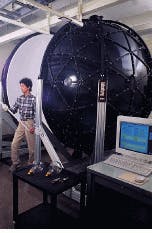An integrating sphere developed by Labsphere (North Sutton, NH) will allow scientists at the National Institute of Standards and Technology (NIST; Gaithersburg, MD) to standardize the lumen, as well as perform absolute calibration of light sources. Previously, luminous flux of light sources—the total light output of a lamp as evaluated by human eye response—has been a comparative measurement, with the lamp output evaluated against a calibrated standard lamp. Such standards are not robust or stable over time, however. With this integrating sphere and the newly developed Absolute Integrating Sphere Method for realization of the lumen, detector-based light source calibration can be performed using a standard photometer, which varies less than 0.1% over the course of a year.
Produced under a Cooperative Research and Development Agreement (CRADA) with NIST, the 2.5-m-diameter sphere is a geodesic dome formed of flanged steel triangles bolted together. Roughly thirty layers of Spectraflect, a barium sulfate-based material, form the reflective inner surface of the sphere. Yoshihiro Ohno of NIST mounts the lamp under test in a fixture in the center of a sphere. The baffle in front of the small opening in the sphere blocks light from entering the detector directly, forcing it to undergo approximately ten bounces prior to detection.
